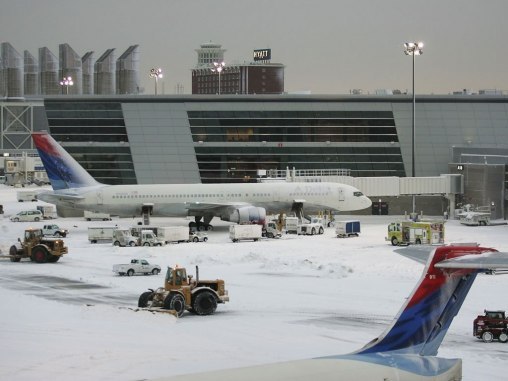By Billie Cohen, CNTraveler.com
Boston's Logan Airport, shown here during a 2010 snowstorm
(Photo: Boston Globe via Getty).
Everyone is freaking out about the northeast's supposed snowpocalypse. And whether the accumulation is more or less than predicted, flights are likely to be affected. We interviewed Brett Snyder (Condé Nast Traveler's top travel specialist for emergency airline assistance, and a contributor to the Daily Traveler blog) to nail down what you need to know -- not only for this storm -- but when dealing with possible flight changes for any storm.
If you have flexibility with your trip, don't wait to make the change.
If you're flexible with your dates and your trip, make the change early. "If you wait, you're going to run out of good, timely options," Snyder cautions. So as soon as an airline's weather waiver policy is announced (and they do a lot to get the word out early, via their own websites and general press releases to news outlets), jump into action to make a flight change. "If you can," says Snyder, "try to get out before the storm. When it's weather you have advance warning; the waiver is going to come out a few days before the storm hits."
If you have no flexibility -- don't act at all.
"If you have no flexibility with your trip, then you might as well ride it out and see what happens," Snyder says. And his point is a good one: If the flight is cancelled, you'll have to scrap your trip anyway, but at least you have a refund.
Don't switch to regional flights.
When cancellations loom, airlines are more likely to cancel regional flights -- while bigger flights and hub-to-hub flights will get priority. "So you kind of want to follow the 'bigger the plane, the better' plan," Snyder says. "There's going to be a reduction in airport capacity, so the airlines are going to have to make cancellations. And in order to impact the fewest people, airlines will more often than not opt to cancel the flights with 50 people on them rather than 150."
Don't believe the airline's initial predictions.
Snyder's advice: Assume the worst. "Don't assume that the airline is going to be able to restart operations exactly as they planned," Snyder says. "The earliest time they start off with is a guess." Just look at the discrepancies we're already seeing: American has cancelled flights at LaGuardia through noon tomorrow; but JetBlue has chosen to cancel through 3 p.m. The airlines aren't able to tell the future; they might have a sense of when the snow will stop, but they don't necessarily know things like how long it will take to remove snow from the tarmac or exactly when their reinstated flights will be able to take off. So if you're changing your flight, put as much padding between the storm and your departure as you can.
